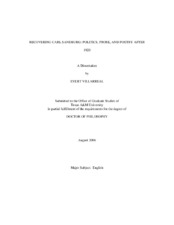| dc.description.abstract | Chapter I of this study is an attempt to articulate and understand the factors that have contributed to Carl Sandburg's declining trajectory, which has led to a reputation that has diminished significantly in the twentieth century. I note that from the outset of his long career of publication - running from 1904 to 1963 - Sandburg was a literary outsider despite (and sometimes because of) his great public popularity though he enjoyed a national reputation from the early 1920s onward. Chapter II clarifies how Carl Sandburg, in various ways, was attempting to re-invent or re-construct American literature. Indeed, beginning in 1922, a very complex creative imagination - one not seen before - began to manifest itself in Sandburg's works. As a result, readers begin to see how Sandburg's view of the role of the writer was shifting - from one of a radical political poet into one of a writer who experimented with several genres. Chapter III examines the two separately published biographies of Abraham Lincoln - Abraham Lincoln: The Prairie Years (1926) and Abraham Lincoln: The War Years (1939) - and reveals how Sandburg incorporates a new perspective that was radically different from the Lincoln biographies that preceded it. Chapter IV turns to Sandburg's celebration of the theme of "the People." The chapter explores four works - The American Songbag (1927), Good Morning, America (1928), The People, Yes (1936), and Remembrance Rock (1948). These works, like all of his previous works, are an effort to make life possible to the common man. Finally, Chapter V reminds readers of Sandburg's stature as witness to the labor problem - perhaps the most significant problem of the twentieth century. I argue that the only way to recover Sandburg correctly is to assess the political ideology present in each of his published works. | en |


